Newport - Bermuda Race
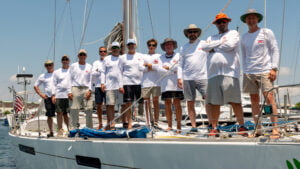
The Newport-Bermuda Race 2024 (also known as “the thrash to the onion patch”) took place from June 21st to June 26th. I’d been crew for the 2022 Newport-Bermuda Race and once again volunteered for this race. I suppose I’m a glutton for punishment…
Participating in this race was not only fun and character-building, but I made the serendipitous decision to store Zanshin in Rodney Bay, St. Lucia rather than my newfound favourite location at Tyrell Bay on Carriacou, Grenada. This choice was made solely because I could use my United Airlines frequent-flier miles from St. Lucia and couldn’t do so from Grenada. During the return trip from Grenada the first hurricane of the season, hurricane Beryl, developed and completely devastated Carriacou! Had I chosen to store Zanshin there, I would have lost her to a female hurricane for the second, and most likely final, time.
Norfolk preparation & delivery to Newport
I arrived in Norfolk from St. Lucia several days early as I knew that there would be some work to do on Challenge Accepted in order to prepare her for the rigours of the race. Over the course of a couple of days, several of us worked on a seemingly unending list of small and large tasks that needed to be completed before our departure. For every 3 items struck off the list, it seemed that another 2 were added. All this work was made much more palatable as David had loaned me his vintage BMW convertible and the weather was perfect for driving with the top down. Each shopping trip was a pleasure rather than a chore.
This year I skippered and helped deliver Challenge Accepted from Norfolk to Newport along with Mack and Bill. Together, we chose benign weather conditions for the 370NM trip. We only got to sail for the first couple of hours; after that the winds and waves subsided and our sails were raised mainly for stability rather than propulsion. We arrived at our first stop at Block Island at noon and spent a night on a mooring before continuing on to Newport. The boat was on the mooring, we went ashore for libations and food.
The final leg into Newport gave us some nice winds, but that experience was marred by the engine failing soon after leaving Block Island. While Bill steered the boat under sail, Mack and I tried to determine the cause of the failure and find a solution. We couldn’t solve the problem, but deduced the probable cause and worked on the assumption that once Challenge Accepted was back on an even keel the engine would once again work. The game plan was now to sail into Newport as far as possible and then motor in the rest of the way. Failing that, we’d sail to a mooring and failing that we’d get either fuel or a tow to a mooring or to our dock. In preparation for the motor failing at an importune moment, we got the anchor prepared, had lines and fenders ready to be deployed at short notice as we knew that the Newport anchorage was going to be both busy and crowded and we wouldn’t have much time to react should things go pear-shaped.
In the end the motor started up with nary a hiccup and we safely motored into our slip at the Newport Yachting Center; but I’d rather waste energy and time in preparing for something that is unlikely to happen than sit there and watch an accident unfold in slow motion.
Newport race preparation
We now had three days in Newport to prepare Challenge Accepted for the rigours ahead, as well as for a large crew of 12. We had to provision for the trip and prepare the sails, plus another list of new tasks and repairs to complete.
One by one the crew trickled into Newport, some sleeping aboard while others chose more comfortable local accommodations prior to the race. Most of us had never met in person, so we combined preparation work with introductions plus getting acquainted over the course of our group work. The list of open tasks quickly got whittled down to a few items that weren’t essential to starting the race.
On the morning of the race the last crewmembers came aboard, and we stored the surprising amount of non-essential gear away and distributed our “hot bunking” berth allocations. Michael held our pre-departure briefing and went over the rules for race including safety items (EPIRBs, PLBs, tethering, life raft) and team allocations and duties and also the planned watch schedules.
Then it was time to shove off and prepare for the start of our racing division and class. Once we crossed the start line, we had a our 630NM race ahead of us.
The Racing Crew
In total we had 12 sailors aboard for the race:
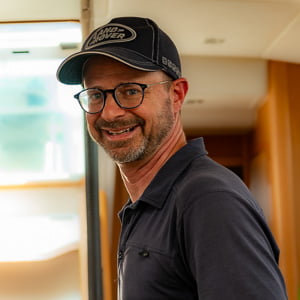 David C. David C. | 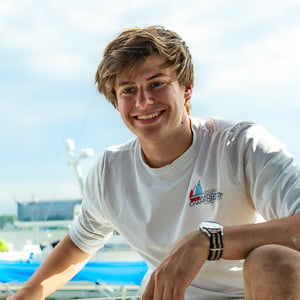 Robert C. Robert C. | 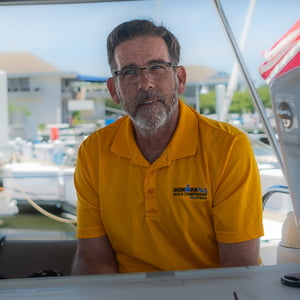 Michael C. Michael C. | 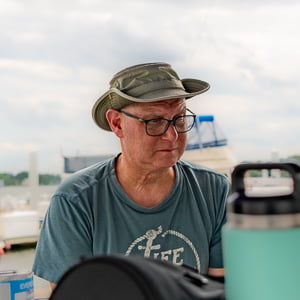 Philip F. Philip F. |
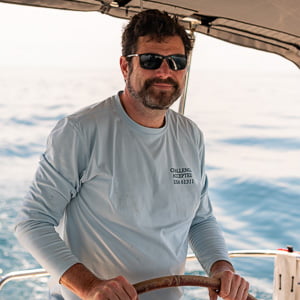 Michael (Mack) M. Michael (Mack) M. | 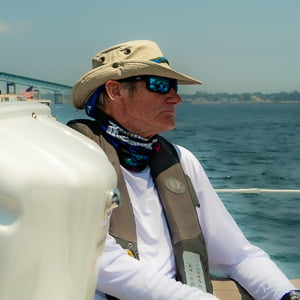 Brian O. Brian O. | 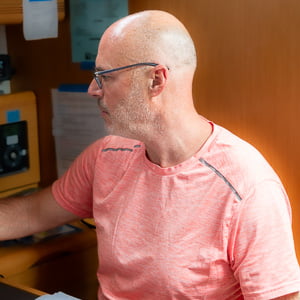 Jess R. Jess R. | 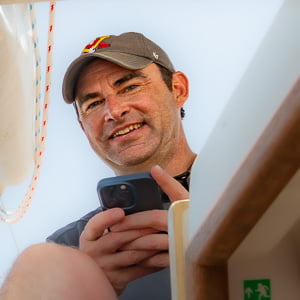 Lloyd T. Lloyd T. |
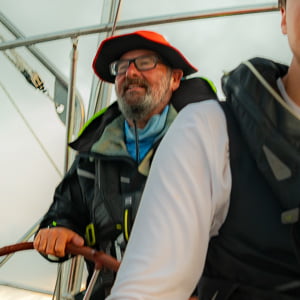 Ron W. Ron W. | 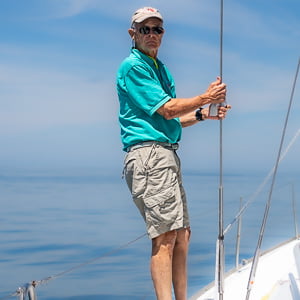 Bill W. Bill W. | 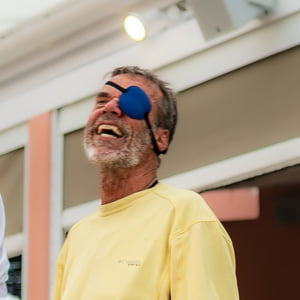 Warren W. Warren W. | 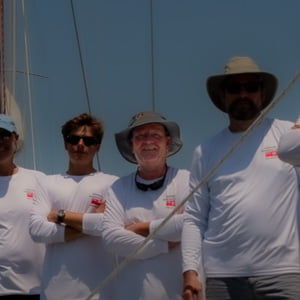 Me Me |
The Race
We had split our crew into to two shifts/teams, termed Alpha and Zulu. Michael, the owner of Challenge Accepted, is skipper and overseer of operations and not assigned to a team; and David is our cook extraordinaire and assigned to assist with sail changes and other deck work. Jess, our navigator, was also outside the team rotation, as he had the difficult task of strategically placing our boat at the front of the fleet! That left one team led by Ron (plus Robert, Bill, Warren) and the other led by Phil (plus Mack, Brian, Lloyd and me) to alternate shifts.
After a good acceptable start, we tried to escape the approaching thunderstorm. But the light winds weren’t enough and we, along with many others, didn’t quite make it and had a long period of barely sufficient wind to keep the boat pointed in the right direction. This frustrating turn of events was compounded by our wind instrumentation failing completely. This isn’t critical for a cruising sailor such as me, but it is a devastating blow on race boat where maintaining the optimal angle is crucial to getting the most out of given conditions. David and I worked with our clamp ammeter and multimeter plus the Raymarine diagnostics while the boat was rolling about, but we weren’t able to repair the electronics; the “magic smoke” had long since departed. That meant all of our sophisticated electronic equipment and Jess’s software had no data to work with and our only wind instrument was the Windex at the masthead and our streaming class flag on the backstay for the remainder of the race.
This wasn’t our only major equipment failure; it was just foreshadowing of things to come.
We’d inspected and Loctite’d the allen screws in the aluminium track for the genoa before the race. Evidently this wasn’t good enough, as once of the track sections parted ways. This left the top and bottom portions of the genoa sail only connected via the cloth and without structural support. Not only that, but the sharp corners of the aluminium extrusions were chafing away at the sail material. Since the conditions were quite rough, the decision was made not to try to lower the sail (potential of jamming in the track while halfway down) or hoisting someone up (potential of arriving in port with one crewmember missing or injured); the genoa was furled to the first reef point to prevent major failure and to mitigate further damage. While this was good for the sail and rig, it didn’t help us point any better and certainly didn’t allow Challenge Accepted to reach the racing speeds she needed to keep up with the leaders of the pack. So, for most of the race we not only had no wind indicators apart from telltales, but we also only had a fraction of our sail area to work with and the winds were such that we couldn’t fly any other or many sails we carried aboard!
With so many people aboard and so many electronic devices, we needed to replenish the power frequently. Our main source of charging was the generator. This failed in the middle of the race, and I couldn’t get it to start again. While this was a setback, it wasn’t too bad until we tried charging using our alternate source of electricity – then engine. This, too, failed and wouldn’t run. The working hypothesis was that the fuel delivery problems were due to the tank being much lower than the engine on our starboard tack and extreme heeling angle. Unfortunately, the winds were forecast to be coming from the same direction for the remainder of the race and going to a port tack would point us away from our goal; this isn’t a particularly good strategy in racing.
So, we went to emergency energy management mode. All electric devices not necessary were turned off and despite this I knew we’d run out of power long before the end of the race. Even the fridge and freezer had to be turned off and, unfortunately, the coffee maker could no longer be used. Fortunately, we could still heat water using the propane stove and make instant coffee and heat up our meals. But the celebratory ice cream in the freezer was now in danger of liquifying.
After some heated discussions with Jess, who maintained that tacking to port for a couple of hours would lose us time, Michael and others chose to do so. After the tack I successfully started up the engine and we charged the batteries; albeit at a relatively slow rate considering the Balmar charger could do so much more. But it was much better than before. The generator wouldn’t start, and I stopped attempting that as I didn’t want to backflood the last cylinder from the cooling water.
It turns out that the tack wasn’t only good for the batteries, it gave us an advantage towards the end of the race as it positioned us for a better final run to the finish line. Nonetheless we crossed the finish with very little battery power left in the bank!
The run to the finish line was fun, with the whole crew aboard and watching us catch up to, and pass, a boat that should have been faster than us. Once we crossed the finish, we all celebrated with a ceremonial beer in honour of the individual who had given Michael the inspiration for the boat name. Unfortunately, this celebration was cut short when we found that we couldn’t furl the genoa. The separation of the top and bottom sections was such that furling rolled up the bottom while tightening the pressure on the top. This would tear the sail, or the furling mechanism, apart. Again, we improvised and thought that since the furling mechanism on the boat didn’t work, we furl the genoa by turning the boat around it. This wasn’t as trivial as it sounded, since the winds were still quite high and both Robert and I got “whacked” several times by flapping sails and lines before the deed was done.
Bermuda is surrounded by reefs and there is only one entrance to get to the main city and docks. Despite the channel being very well-marked and wide/deep enough for cruise ships, it still demands a lot of concentration, and it takes hours to get from the sea to the dock. We finished around 6AM and didn’t get to Hamilton until after 9AM. I’d done this entrance in the dark last time, but this finish was during the day, and it is hard to believe that all that wonderfully blue and green water to the north of the channel hides so much shallow and dangerous coral.
Our progress in relation to the other racers can be seen here
Bermuda and return delivery to Norfolk
Bermuda is the Switzerland of the Americas – it is quite pricey. Known for both potatoes, the Bermuda Triangle and the ubiquitous Dark and Stormy drink, it is not part of the Caribbean yet has a very warm climate, thanks to the Gulf Stream.
I only remained for two nights after we arrived, as the conditions for the return trip gave me only a few options for a comfortable return delivery. I’d chosen to depart on Sunday, allowing a front to pass and light conditions to permit a good return. But Friday was brought forward as an option, and that would entail 3 days of very light conditions and then we’d come behind a cold front around the gulf stream. I changed my mind and opted for an early departure – that would also let me catch my originally booked flight back to Germany.
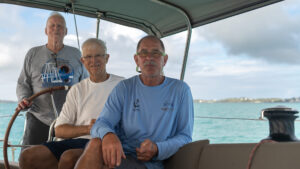
The return crew consisted of myself and Bill, plus two new members – David and Jim. David is extremely experienced and certainly could have taken care of skippering the 640NM return delivery. But I got there first :). Jim arrived on Thursday evening we managed to get him into the country and cleared out of the country at the same time at the airport. The immigration officer I cleared out with told me that he was working at the airport after his shift at the yacht club; and he personally did the paperwork for Jim. That allowed us to leave the RBYC in the early hours rather than have to wait for Customs & Immigration.
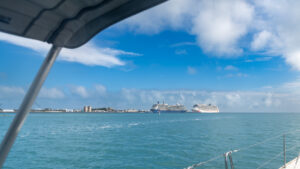
The weather was beautiful, and we departed without incident at 09:00, assisted by the RBYC crew. I called Bermuda Radio on the VHF to announce our intentions of leaving and was granted permission along with a stern warning to stick to the marked channel. We certainly did so, sticking close to the GPS track we’d made while entering.
Once again, we spent 3 hours in the channel, departing the coral-protected waters of Bermuda. All the 3 we were traveling in the wrong direction the whole time!
The winds were going to be light, under 8 knots, from roughly behind us for the next 3 days so we settled in for comfortable motorsailing. The genoa had been partially repaired, but we still had to keep a bit more than the first reef. I’d also stored the light wind sails deep down in the sail locker and with a short-handed crew I chose not to attempt to fly the spinnaker, even during the daylight hours.
The “champagne sailing” ended on the last day. Two potentially adverse conditions were ahead of us – the gulf stream crossing of about 100Km and a strong cold frontal passage. I’d hoped that the weather forecast was right and that we’d pass through behind the front – but despite being slower than planned, the front was even slower. The winds and waves grew steadily over the course of hours, and we found ourselves approaching the first black wall of embedded thunderstorms with a triple-reefed main and triple-reefed genoa. The radar showed that we were going to pass between to major cells, and I thought we were going to be lucky…
Those to cells were just the front line in a long procession of dark clouds. While we never counted less than 5 seconds between seeing lightning and hearing the associated thunderclap, it felt like we were surrounded. Without functioning wind instruments I could only guess at the winds; but we had a lot of spindrift around us on the water and that usually starts at Force 8 (34 knots). The seas weren’t particularly large at somewhere around 8 feet and more on occasion, but they were quite confused and made steering difficult. When we first approached the frontal boundary, I’d taken the helm as I didn’t know how strong those initial gusts would and whether the autopilot could handle it. I steered through the storm until I was tired, cold and soaked to the core – then decided that the boat was well-balanced, and that “Otto” could take over. I joined Zed and Jim in the cover of the dodger. They’d sensibly remained there and remained dry and warm in the protected zone. I should have joined them earlier! While I never felt that the boat or crew was in any way overpowered or overstressed, the same frontal system caused another returning Bermuda raceboat to sink! They were far north of us and most certainly experienced tougher conditions than we were exposed to.
I was shivering and a bit hypothermic when I went off shift, changed into dry clothes and went to my bunk to sleep. I wasn’t on shift until 04:00 but couldn’t let myself drift off into deep sleep as the boat was still getting slammed around in the seas – but the crew was more than competent and bit-by-bit the winds subsided and waves got unionized (organized) and settled.
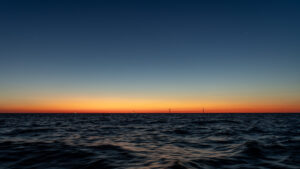
By the time I was woken for my shift the conditions were once again calm and I experienced a wonderful sunrise while still about 40 miles offshore from Norfolk. It reminded me of why I love to sail; sipping a freshly brewed coffee with my bare feet propped on the cockpit table and enjoying the endless uninterrupted vista.
Soon Jim and Zed joined me, both refreshed after their strenuous shifts. Bill had taken the watch before me, so was still asleep. He joined us a bit later, not wanting to miss our arrival.
Having a great crew like this is important – not only did I trust them to handle the ship (perhaps even better than I), but we got along well, too!
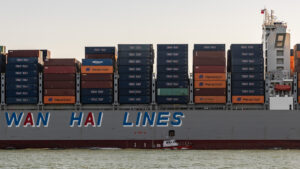
Coming into Norfolk, we stayed to port of the shipping channel (the TSS), but a big container ship still honked at us. Soon we saw the pilot boat come past us and transfer the pilot onboard – then it zipped up next to us and the pilot shouted over “Mike asks why you guys are so slow!”. I’d forgotten that one of the pilots is a good friend of Mike’s!
Unlike clearing in/out in the Caribbean, we didn’t have to go to Customs & Immigration – they came to us! First, we had a visit from a lady from Customs and she was friendly, even letting us “slide” a little bit as I’d forgotten about the rules for bringing in fruit and garbage, even though the fruit had been purchased in the USA. Then two gentlemen from Immigration came to clear us in. This was made more difficult because I was a foreigner, but my I-94 was still valid, so it took mere seconds to legally clear me in. The other crewmembers were all Americans, so that went smoothly as well.
I was given another loaner car by David, but when he told me that I’d get the Volve I envisioned a 80’s era “beater”. Much to my surprise this was a cool hybrid 500HP monster. Wowser!
Zed and Jim were going to depart for Annapolis on the morning after our arrival to do another delivery, this one somewhat shorter and only going to New York. We had a grand final night out together at Elation, a local microbrewery and were joined by Lloyd and Mac.
I had one more full day in Norfolk, starting with driving Zed and Jim to the train station in the morning, then doing some cleaning aboard Challenge Accepted, doing my laundry and then having a final steak dinner (which I’d been craving) at the Byrd & Baldwin with Michael and Anne plus Mack and Andria.
